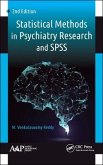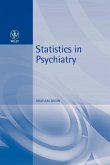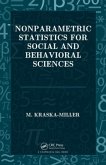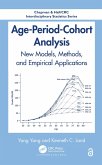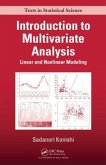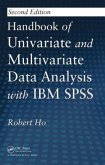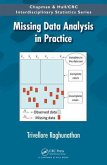Capture-Recapture Methods for the Social and Medical Sciences
Herausgeber: Bohning, Dankmar; Bunge, John; Heijden, Peter G M van der
Capture-Recapture Methods for the Social and Medical Sciences
Herausgeber: Bohning, Dankmar; Bunge, John; Heijden, Peter G M van der
- Gebundenes Buch
- Merkliste
- Auf die Merkliste
- Bewerten Bewerten
- Teilen
- Produkt teilen
- Produkterinnerung
- Produkterinnerung
Capture-recapture methods have recently become popular in the social and medical sciences to estimate the size of elusive populations such as illicit drug users or people with a drinking problem. This book brings together important developments which allow the application of these methods with contributions from more than 40 researchers.
Andere Kunden interessierten sich auch für
![Statistical Methods in Psychiatry Research and SPSS Statistical Methods in Psychiatry Research and SPSS]() M Venkataswamy ReddyStatistical Methods in Psychiatry Research and SPSS176,99 €
M Venkataswamy ReddyStatistical Methods in Psychiatry Research and SPSS176,99 €![Statistics in Psychiatry Statistics in Psychiatry]() Graham DunnStatistics in Psychiatry55,99 €
Graham DunnStatistics in Psychiatry55,99 €![Nonparametric Statistics for Social and Behavioral Sciences Nonparametric Statistics for Social and Behavioral Sciences]() M. Kraska-MillerNonparametric Statistics for Social and Behavioral Sciences127,99 €
M. Kraska-MillerNonparametric Statistics for Social and Behavioral Sciences127,99 €![Age-Period-Cohort Analysis Age-Period-Cohort Analysis]() Yang YangAge-Period-Cohort Analysis153,99 €
Yang YangAge-Period-Cohort Analysis153,99 €![Introduction to Multivariate Analysis Introduction to Multivariate Analysis]() Sadanori KonishiIntroduction to Multivariate Analysis144,99 €
Sadanori KonishiIntroduction to Multivariate Analysis144,99 €![Handbook of Univariate and Multivariate Data Analysis with IBM SPSS Handbook of Univariate and Multivariate Data Analysis with IBM SPSS]() Robert HoHandbook of Univariate and Multivariate Data Analysis with IBM SPSS127,99 €
Robert HoHandbook of Univariate and Multivariate Data Analysis with IBM SPSS127,99 €![Missing Data Analysis in Practice Missing Data Analysis in Practice]() Trivellore RaghunathanMissing Data Analysis in Practice110,99 €
Trivellore RaghunathanMissing Data Analysis in Practice110,99 €-
-
-
Capture-recapture methods have recently become popular in the social and medical sciences to estimate the size of elusive populations such as illicit drug users or people with a drinking problem. This book brings together important developments which allow the application of these methods with contributions from more than 40 researchers.
Hinweis: Dieser Artikel kann nur an eine deutsche Lieferadresse ausgeliefert werden.
Hinweis: Dieser Artikel kann nur an eine deutsche Lieferadresse ausgeliefert werden.
Produktdetails
- Produktdetails
- Verlag: CRC Press
- Seitenzahl: 462
- Erscheinungstermin: 17. Juli 2017
- Englisch
- Abmessung: 254mm x 178mm x 25mm
- Gewicht: 1021g
- ISBN-13: 9781498745314
- ISBN-10: 1498745318
- Artikelnr.: 48850149
- Herstellerkennzeichnung
- Libri GmbH
- Europaallee 1
- 36244 Bad Hersfeld
- gpsr@libri.de
- Verlag: CRC Press
- Seitenzahl: 462
- Erscheinungstermin: 17. Juli 2017
- Englisch
- Abmessung: 254mm x 178mm x 25mm
- Gewicht: 1021g
- ISBN-13: 9781498745314
- ISBN-10: 1498745318
- Artikelnr.: 48850149
- Herstellerkennzeichnung
- Libri GmbH
- Europaallee 1
- 36244 Bad Hersfeld
- gpsr@libri.de
Dankmar Böhning is Professor of Medical Statistics and Director of the Southampton Statistical Sciences Research Institute at the University of Southampton. His interests are in capture-recapture modelling, meta-analysis and research synthesis as well as mixed modelling. John Bunge is Professor of Statistics in the Department of Statistical Science of Cornell University. His interests are capture-recapture modelling, microbiome statistics, and nonclassical probability distribution theory. Peter. G.M. van der Heijden is Professor of Social Statistics at the University of Utrecht and at the University of Southampton. His interests are capture-recapture modelling for the Social Sciences and Official Statistics.
I Introductory Part
Basic concepts of capture-recapture
II Ratio Regression Models
Ratio regression and capture-recapture
The Conway-Maxwell-Poisson distribution and capture-recapture count data
The geometric distribution, the ratio plot under the null and the burden of
Dengue Fever in Chiang Mai province
A ratio regression approach to estimate the size of the Salmonella infected
flock population using validation information
III Meta-Analysis in Capture-Recapture
On meta-analysis in capture-recapture
A case study on maritime accidents using meta-analysis in capture-recapture
A meta-analytic generalization of the Lincoln-Petersen-estimator for
mark-and-resight studies
IV Extensions of Single Source Models
Estimating the population size via the empirical probability generating
function
Convex estimation
Non-parametric estimation of the population size using the empirical
probability generating function
Extending the truncated Poisson regression model to a time-at-risk model
Extensions of the Chao-estimator for covariate information: Poisson case
Population size estimation for one-inflated count data based upon the
geometric distribution
V Multiple Sources
Dual and multiple system estimation: fully observed and incomplete
covariates
Population size estimation in CRC Models with continuous covariates
Trimmed dual system estimation
Estimation of non-registered usual residents in the Netherlands
VI Latent Variable Models
Population size estimation using a categorical latent variable
Latent class - Rasch models and marginal extensions
Performance of hierarchical log-linear models for a heterogeneous
population with three lists
A multidimensional Rasch model for multiple system estimation where the
number of lists changes over time
Extending the Lincoln-Petersen estimator when both sources are counts
VII Bayesian Approaches
Objective Bayes estimation of the population size using Kemp distributions
Bayesian population size estimation with censored counts
VIII Miscellaneous Topics
Uncertainty assessment in capture-recapture studies and the choice of
sampling effort
Basic concepts of capture-recapture
II Ratio Regression Models
Ratio regression and capture-recapture
The Conway-Maxwell-Poisson distribution and capture-recapture count data
The geometric distribution, the ratio plot under the null and the burden of
Dengue Fever in Chiang Mai province
A ratio regression approach to estimate the size of the Salmonella infected
flock population using validation information
III Meta-Analysis in Capture-Recapture
On meta-analysis in capture-recapture
A case study on maritime accidents using meta-analysis in capture-recapture
A meta-analytic generalization of the Lincoln-Petersen-estimator for
mark-and-resight studies
IV Extensions of Single Source Models
Estimating the population size via the empirical probability generating
function
Convex estimation
Non-parametric estimation of the population size using the empirical
probability generating function
Extending the truncated Poisson regression model to a time-at-risk model
Extensions of the Chao-estimator for covariate information: Poisson case
Population size estimation for one-inflated count data based upon the
geometric distribution
V Multiple Sources
Dual and multiple system estimation: fully observed and incomplete
covariates
Population size estimation in CRC Models with continuous covariates
Trimmed dual system estimation
Estimation of non-registered usual residents in the Netherlands
VI Latent Variable Models
Population size estimation using a categorical latent variable
Latent class - Rasch models and marginal extensions
Performance of hierarchical log-linear models for a heterogeneous
population with three lists
A multidimensional Rasch model for multiple system estimation where the
number of lists changes over time
Extending the Lincoln-Petersen estimator when both sources are counts
VII Bayesian Approaches
Objective Bayes estimation of the population size using Kemp distributions
Bayesian population size estimation with censored counts
VIII Miscellaneous Topics
Uncertainty assessment in capture-recapture studies and the choice of
sampling effort
I Introductory Part
Basic concepts of capture-recapture
II Ratio Regression Models
Ratio regression and capture-recapture
The Conway-Maxwell-Poisson distribution and capture-recapture count data
The geometric distribution, the ratio plot under the null and the burden of
Dengue Fever in Chiang Mai province
A ratio regression approach to estimate the size of the Salmonella infected
flock population using validation information
III Meta-Analysis in Capture-Recapture
On meta-analysis in capture-recapture
A case study on maritime accidents using meta-analysis in capture-recapture
A meta-analytic generalization of the Lincoln-Petersen-estimator for
mark-and-resight studies
IV Extensions of Single Source Models
Estimating the population size via the empirical probability generating
function
Convex estimation
Non-parametric estimation of the population size using the empirical
probability generating function
Extending the truncated Poisson regression model to a time-at-risk model
Extensions of the Chao-estimator for covariate information: Poisson case
Population size estimation for one-inflated count data based upon the
geometric distribution
V Multiple Sources
Dual and multiple system estimation: fully observed and incomplete
covariates
Population size estimation in CRC Models with continuous covariates
Trimmed dual system estimation
Estimation of non-registered usual residents in the Netherlands
VI Latent Variable Models
Population size estimation using a categorical latent variable
Latent class - Rasch models and marginal extensions
Performance of hierarchical log-linear models for a heterogeneous
population with three lists
A multidimensional Rasch model for multiple system estimation where the
number of lists changes over time
Extending the Lincoln-Petersen estimator when both sources are counts
VII Bayesian Approaches
Objective Bayes estimation of the population size using Kemp distributions
Bayesian population size estimation with censored counts
VIII Miscellaneous Topics
Uncertainty assessment in capture-recapture studies and the choice of
sampling effort
Basic concepts of capture-recapture
II Ratio Regression Models
Ratio regression and capture-recapture
The Conway-Maxwell-Poisson distribution and capture-recapture count data
The geometric distribution, the ratio plot under the null and the burden of
Dengue Fever in Chiang Mai province
A ratio regression approach to estimate the size of the Salmonella infected
flock population using validation information
III Meta-Analysis in Capture-Recapture
On meta-analysis in capture-recapture
A case study on maritime accidents using meta-analysis in capture-recapture
A meta-analytic generalization of the Lincoln-Petersen-estimator for
mark-and-resight studies
IV Extensions of Single Source Models
Estimating the population size via the empirical probability generating
function
Convex estimation
Non-parametric estimation of the population size using the empirical
probability generating function
Extending the truncated Poisson regression model to a time-at-risk model
Extensions of the Chao-estimator for covariate information: Poisson case
Population size estimation for one-inflated count data based upon the
geometric distribution
V Multiple Sources
Dual and multiple system estimation: fully observed and incomplete
covariates
Population size estimation in CRC Models with continuous covariates
Trimmed dual system estimation
Estimation of non-registered usual residents in the Netherlands
VI Latent Variable Models
Population size estimation using a categorical latent variable
Latent class - Rasch models and marginal extensions
Performance of hierarchical log-linear models for a heterogeneous
population with three lists
A multidimensional Rasch model for multiple system estimation where the
number of lists changes over time
Extending the Lincoln-Petersen estimator when both sources are counts
VII Bayesian Approaches
Objective Bayes estimation of the population size using Kemp distributions
Bayesian population size estimation with censored counts
VIII Miscellaneous Topics
Uncertainty assessment in capture-recapture studies and the choice of
sampling effort


